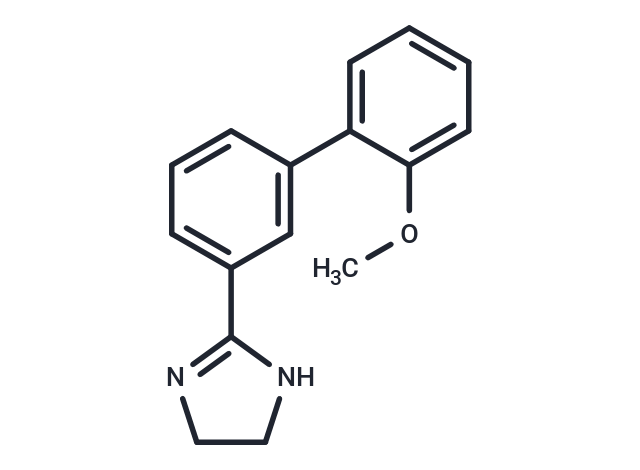- Remove All
 Your shopping cart is currently empty
Your shopping cart is currently empty
5-HT7R antagonist 2
Compound 4h, also known as 5-HT7R antagonist 2, is a selective inhibitor of the 5-HT7R that disrupts both G protein and β-arrestin signaling pathways. It exhibits a K_i value of 67 nM, with IC_50 values of 2.59 μM in cAMP assays and 39.57 μM in Tango tests. This antagonist is noted for its potential to mitigate repetitive behaviors associated with autism spectrum disorder (ASD) and to foster the restoration of neurogenesis impaired by ASD [1]. Pharmacokinetic analysis in ICR male mice following intravenous and intraperitoneal administration shows a T_max of 0.08 hours and 0.25 hours, a T_1/2 of 0.77 hours and 1.06 hours, and a C_max of 33.07 ng/mL and 156.44 ng/mL, respectively. The AUC_last was recorded at 28.31 ng·h/mL and 143.27 ng·h/mL, with a clearance rate (CL) of 41.61 L/h/kg for intravenous administration. The volume of distribution at steady state (V_ss) was 32.43 L/kg, the mean residence time (MRT) was 0.79 hours and 0.93 hours, and the bioavailability (F) was calculated at 50.60% [1].

5-HT7R antagonist 2
| Pack Size | Price | Availability | Quantity |
|---|---|---|---|
| 10 mg | Inquiry | 10-14 weeks | |
| 50 mg | Inquiry | 10-14 weeks |
Product Introduction
| Description | Compound 4h, also known as 5-HT7R antagonist 2, is a selective inhibitor of the 5-HT7R that disrupts both G protein and β-arrestin signaling pathways. It exhibits a K_i value of 67 nM, with IC_50 values of 2.59 μM in cAMP assays and 39.57 μM in Tango tests. This antagonist is noted for its potential to mitigate repetitive behaviors associated with autism spectrum disorder (ASD) and to foster the restoration of neurogenesis impaired by ASD [1]. Pharmacokinetic analysis in ICR male mice following intravenous and intraperitoneal administration shows a T_max of 0.08 hours and 0.25 hours, a T_1/2 of 0.77 hours and 1.06 hours, and a C_max of 33.07 ng/mL and 156.44 ng/mL, respectively. The AUC_last was recorded at 28.31 ng·h/mL and 143.27 ng·h/mL, with a clearance rate (CL) of 41.61 L/h/kg for intravenous administration. The volume of distribution at steady state (V_ss) was 32.43 L/kg, the mean residence time (MRT) was 0.79 hours and 0.93 hours, and the bioavailability (F) was calculated at 50.60% [1]. |
| Targets&IC50 | 5-HT 7 Receptor:67 nM (Ki) |
| In vitro | 5-HT7R antagonist 2 (compound 4h) demonstrates significant metabolic stability when incubated with microsomes for 30 minutes and shows no cytotoxicity [1]. In both the G protein and β-arrestin signaling pathways, 5-HT7R antagonist 2 acts as a competitive antagonist [1]. |
| In vivo | Compound 4h acts as a 5-HT7R antagonist and, when administered intraperitoneally at a dosage of 5 mg/kg for 30 minutes, has potential for modulating repetitive behaviors in ASD animal models. This compound also enhances the number of immature neurons associated with ASD [1]. Animal Model: ASD animal models. Dosage: 5 mg/kg. Administration: Intraperitoneal injection. Result: 4h can increase the number of immature ASD neurons. |
| Molecular Weight | 252.31 |
| Formula | C16H16N2O |
| Cas No. | 1448808-50-1 |
| Storage | Powder: -20°C for 3 years | In solvent: -80°C for 1 year | Shipping with blue ice. |
Calculator
In Vivo Formulation Calculator (Clear solution)
Dose Conversion
Tech Support

Copyright © 2015-2025 TargetMol Chemicals Inc. All Rights Reserved.




